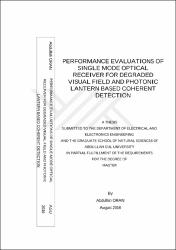| dc.contributor.author | ORAN, ABDULLAH | |
| dc.date.accessioned | 2020-07-21T07:37:15Z | |
| dc.date.available | 2020-07-21T07:37:15Z | |
| dc.date.issued | 2016 | en_US |
| dc.identifier.other | Tez No: 434248 | |
| dc.identifier.uri | https://hdl.handle.net/20.500.12573/301 | |
| dc.description.abstract | Imaging at degraded visual environments is one of the biggest challenges in today’s imaging technologies. Especially military and commercial rotary wing aviation is suffering from impaired visual field in sandy, dusty, marine and snowy environments. For example, during landing the rotor churns up the particles and creates dense clouds of highly scattering medium, which limits the vision of the pilot and may result in an uncontrolled landing. The vision in such environments is limited because of the high ratio of scattered photons over the ballistic photons that have the image information. In this thesis, we propose to use optical spatial filtering (OSF) method in order to eliminate the scattered photons and mainly collect the ballistic photons at the receiver. OSF is widely used in microscopy; to the best of our knowledge this thesis will be the first application of OSF for macroscopic imaging. Our experimental results show that most of the scattered photons are eliminated using the spatial filtering in a highly scattering degraded visual field. The results are compared with a standard broad area photo detector which shows the effectiveness of spatial filtering. Free space optical systems have applications in different areas such as laser ranging, three-dimensional imaging, weather predictions and optical wireless communication. Some applications require very high performance free space optical systems that are not available today. The need of systems with higher performance and lower size, weight and power (SWaP) is the biggest research motivation of free space optical systems. Between various detection techniques, vi coherent optical detection comes forward for applications that require high sensitivity and bandwidth. Coherent detection based LIDAR systems have the potential to provide quantum noise limited performance. However coherent systems suffer from poor free space to fiber collection efficiency due to the single mode detection characteristics and small size of the optical fiber. In order to overcome this problem, photonic lantern is introduced to effectively collect the multimode beam coming from free space and convert it to a number of single mode fibers. The photonic lantern consists of a multimode fiber to a number of single-mode fibers. The collection efficiency enhancement of photonic lanterns have been investigated, however there is no study on the signal to noise ratio –performance- improvement on the photonic lantern based free space coherent systems. In this thesis; the effect of random distribution of the optical power in the 19-port photonic lantern will be investigated mathematically. The photonic lantern based coherent detection system performance will also be simulated by using the MATLAB software. The output of this thesis may open the path to experimental demonstration and maybe even to a prototype. | en_US |
| dc.language.iso | eng | en_US |
| dc.publisher | Abdullah Gül Üniversitesi | en_US |
| dc.rights | info:eu-repo/semantics/openAccess | en_US |
| dc.subject | Single mode optical receiver | en_US |
| dc.subject | Degraded visual field | en_US |
| dc.subject | Photonic lantern | en_US |
| dc.subject | LIDAR | en_US |
| dc.subject | Coherent detection | en_US |
| dc.title | PERFORMANCE EVALUATIONS OF SINGLE MODE OPTICAL RECEIVER FOR DEGRADED VISUAL FIELD AND PHOTONIC LANTERN BASED COHERENT DETECTION | en_US |
| dc.type | masterThesis | en_US |
| dc.contributor.department | AGÜ, Fen Bilimleri Enstitüsü, Elektrik ve Bilgisayar Mühendisliği Ana Bilim Dalı | en_US |
| dc.contributor.institutionauthor | ORAN, ABDULLAH | |
| dc.relation.publicationcategory | Tez | en_US |


















